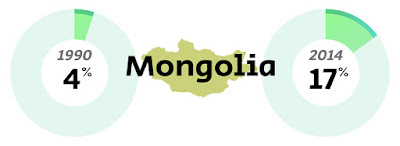It's the week after Thanksgiving, and there's a lot to be thankful for in our world.
When I published The Secret Peace in 2009, the headlines looked bad. The world was mired in the worst global economic crisis since the Great Depression. But all the underlying data, the long-term data, told a different story: Sure, the world is a terrible place, but it used to be much worse. Slowly, inexorably, through the cumulative day-to-day efforts of millions of people, it keeps getting better.
Today, it seems like the headlines are even worse. Clearly, not everything gets better all the time, and history repeats itself - or echoes itself, at least. But the spiral of repetition also rises up, if slowly. Nothing I have seen in the past decade has changed my mind about the overall Secret Peace thesis - not when you look at the world as a whole.
I've posted on this blog for 10 years now, whenever I find positive articles - hidden gems that are often overlooked because they're not as immediate, salacious, or urgent. These articles aren't "positive" in that they're uplifting slice-of-life stories, like a dog rescuing a kidney donor or schoolkids punching cancer. Those type of stories - while fine and even necessary - are just as anecdotal as the many negative stories the media often covers: plane crash, school shooting, wildfire, shark attack, political scandal. And anecdotal evidence is never going to give us a true sense of the state of the world.
Rather, the best articles I've found tend to have clues that corroborate particular long-term positive trends. Indeed, almost all positive change tends to be very long-term, and that makes it very hard to see.
I've taken a hiatus from writing here for a while, and this post wraps that up more formally. I've had too many other busy strands of life going on. But I hope you'll continue to keep an eye out for these type of articles yourself, while treating the "regular" news with a bit more skepticism. Look at what you're reading and watching, and try to get just the facts. If you want some opinions, too, look for them from both sides of the aisle. This extremely useful chart is the best guide I've found to help us all control our media diet.
I've rounded up a last batch of Secret Peace articles for now - each with a statistic to make us stop and think:
- "Every day, the number of people around the world living in extreme poverty (less than about $2 a day) goes down by 217,000."
- - Why 2017 was the best year in human history - Nicholas Kristoff, NY Times
- "Since 2000, global malaria deaths have declined by 60 percent. Since their peak a decade ago, AIDS-related deaths have fallen by 45 percent."
- - Never forget that we live in the best of times - Philip Collins, The Times (UK)
- "The essential finding of Steven Pinker’s 2011 book The Better Angels of Our Nature seems to have been largely accepted: that we are living in history’s most peaceful era, with violence of all kinds – from deaths in war to schoolyard bullying – in steep decline."
- - Is the world really better than ever? - Oliver Burkeman, The Guardian
- "Mass school shootings are incredibly rare events. ... Shooting incidents involving students have been declining since the 1990s. ... More kids are killed each year from pool drownings or bicycle accidents."
- - Schools are safer than they were in the 90s ... - Allie Nicodemo and Lia Petronio, Northeastern
- "Sharkey, studying the crime decline in six American cities, concludes, 'As the degree of violence has fallen, the gap between the neighborhoods of the poor and nonpoor has narrowed.'"
- - The Great Crime Decline - Adam Gopnick, The New Yorker
- "American gun ownership drops to lowest rate in nearly 40 years."
- - American gun ownership drops ... - Christopher Ingraham, Washington Post
- "Ethiopia and Eritrea Declare an End to Their [two-decade-long] War."
- - Ethiopia and Eritrea Declare an End to Their War - Selam Gebrekidan, New York Times
- "Fewer Americans dying of cancer."
2018 is the 10th-year anniversary of posting on this blog. I want to extend a heartfelt thanks to everyone who has taken the time either to read my book, or read these articles here, share, and comment. One exciting final trend to mention is that there are now enough people writing about positive trends that our group has a label: the "New Optimists". Personally, I'm optimistic that this group will continue to grow.



















